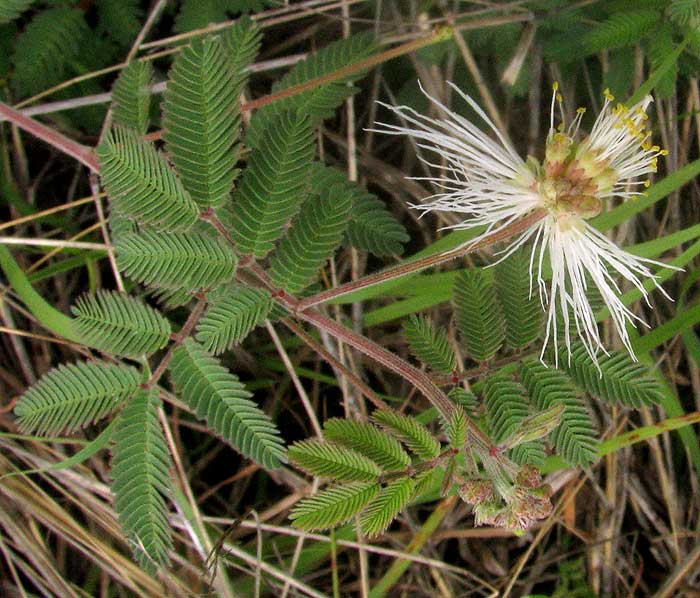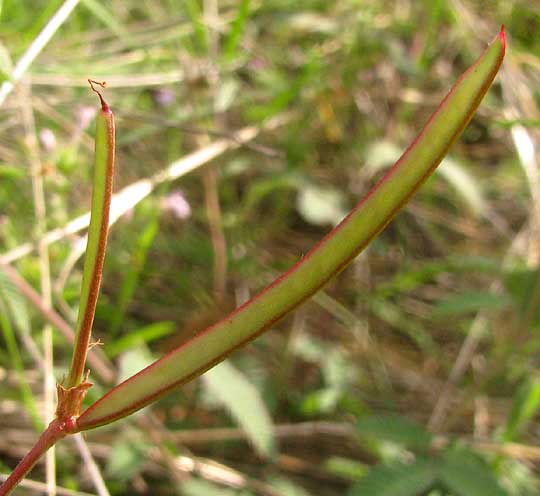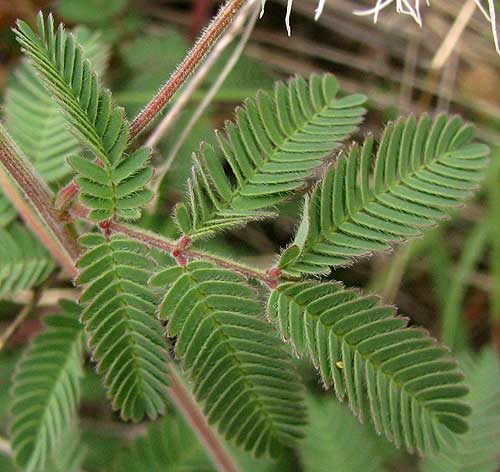Excerpts from Jim Conrad's
Naturalist Newsletter

from the June 22, 2014 Newsletter issued from the Frio Canyon Nature Education Center in the valley of the Dry Frio River in northern Uvalde County, southwestern Texas, on the southern border of the Edwards Plateau; elevation ~1750m (~5750 ft); N29.62°, W99.86°; USA
VELVET BUNDLEFLOWER
In beat-down, tall grass along the one-lane gravel road up the Dry Frio Valley a smallish, low-growing plant with ferny leaves and powderpuff-like clusters of white flowers sprawled atop the grass, as shown below:

Serious flower sniffers, seeing those ferny leaves and powderpuff-like clusters of flowers, immediately recognize not only that our plant is a member of the big Bean Family, but also of the Mimosa Subfamily, the Mimosoideae. Besides mimosas, well known members of that subfamily include acacias and Silktrees (Albizia), both with ferny leaves and powderpuff inflorescences. Our plant confirms its membership in the Bean Family by producing the two-inch-long (5cm), legume-type fruits, shown below:

A closer look at our plant's mimosa-like leaves, which are compound, with tiny leaflets, plus the flower cluster, appears at the top of this page. A twice-divided, or "bipinnate," leaf showing how heavily invested our plant is with short, soft hairs, giving it a velvety appearance and feeling, is shown below:

A closer look at a cluster of flowers is seen below:

Here you see eight or so tiny flowers closely clustered in the head's center, each flower with a purple-tinged calyx and greenish corolla, from which arise ten stamens composed of long, white filaments topped with oval, yellow anthers. Something unusual about this flowering head is that below the cluster of stamen-producing flowers there's a ring of several other flowers, but these are held horizontally and the white filaments issuing from each flower are much longer than those of the central flowers, and bear no yellow anthers. These flowers forming a fluffy, white "collar" for the flowering head are sterile, apparently serving to better attract pollinators.
Though a mind-boggling number of Bean Family plants occur in Texas, only a small fraction of those are member of the Mimosa Subfamily. Shinners & Mahler's Illustrated Flora of North Central Texas includes only six genera, a number the mind can handle.
Among Texas' s Mimosa Subfamily members, our roadside plant's genus quickly identifies itself with three easy-to-see field marks: Plants are not woody; they bear no spines, and; their flowers are white. The genus is Desmanthus, whose species often are known as bundleflowers.
In our area we might conceivably encounter seven or so Desmanthus species. Desmanthus is mostly a Mexican genus (14 species), so, being so close to Mexico, that explains why we have so many species.
Our Desmanthus easily distinguishes itself from the other possible species because of its conspicuous, velvety hairiness. Some other species may have a few hairs, but nothing compared to our species' covering.
Our roadside species often is known as the Velvet Bundleflower. It's DESMANTHUS VELUTINUS, mostly occurring in northern Mexico, but in the US found in southern Arizona, New Mexico and much of Texas. Typically it occurs on slopes with limestone or caliche soils. The road where the plant occurred was on limestone.
Velvet Bundleflower is a useful species, its spineless leaves and stems being eaten by various grazing animals, and birds such as quail eating its seeds. Its seeds often are included in seed mixes used for range improvement.